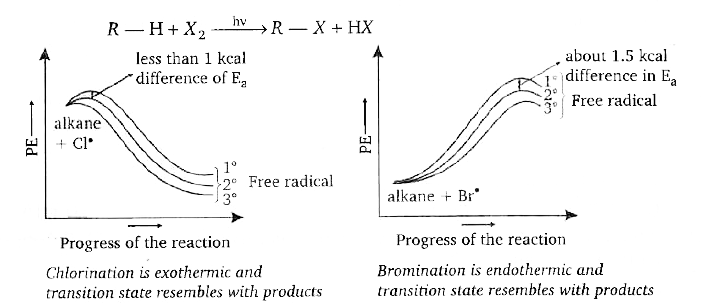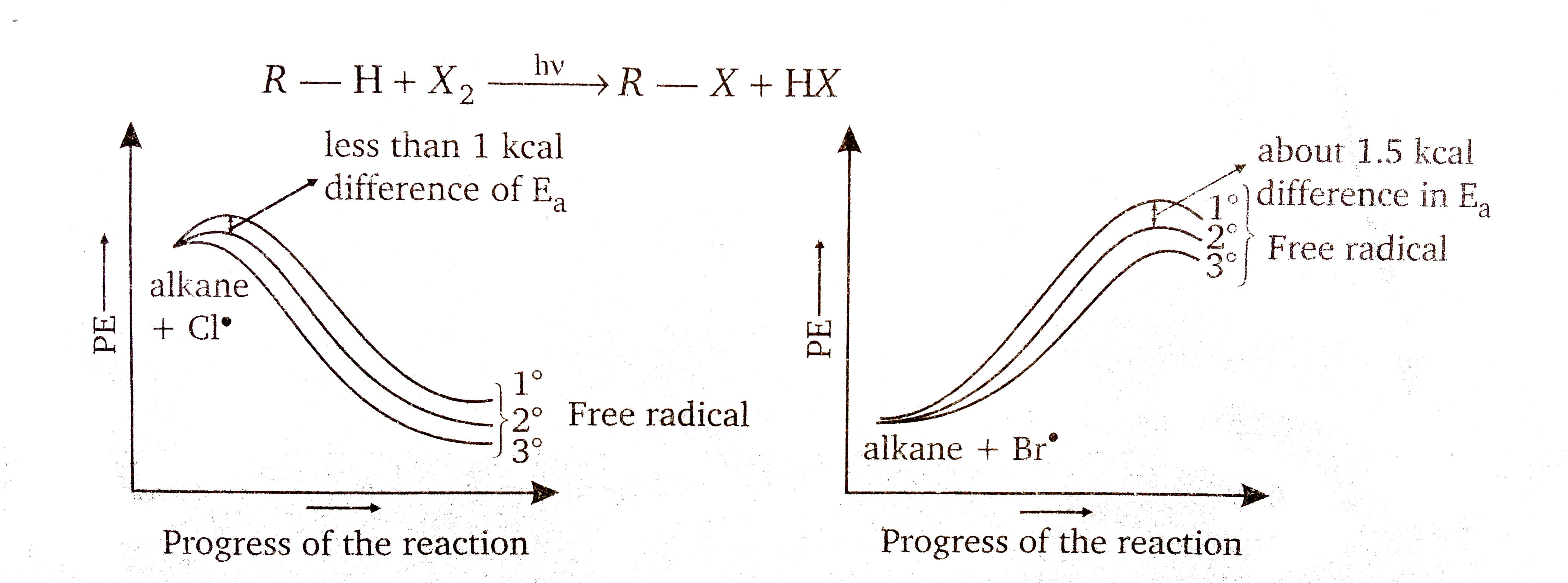Halogenation is a substitution reaction, where halogen replaces one or more hydrogens of hydrocarbon.

Chlorine free radical make 1∘,2∘,3∘ radicals with almost equal ease, whereas bromine free radicals have a clear preference for the formation of tertiary free radicals. So, bromine is less reactive, and more slective whereas chlorine is less selective and more reactive.
The relative rate of abstraction of hydrogen by Br is
3∘>2∘>1∘(1600)(82)(1)
The relative rate of abstraction of hydrogen by Cl is
3∘>2∘>1∘(5)(3.8)(1)
CH3−CH3∣CH−CH3Cl2/hv−−−→ Product
Major product in the above reaction is : Solution in Telugu
CH3−CH3∣CH−CH2−Cl
CH3−CH3∣CH∣Cl−CH3
CH3−CH2−CH2−Cl
CH3−Cl∣CH∣Cl−CH2−CH3
The correct Answer is:A
CH3−CH3∣CH−CH2−Cl Relative formation is =9×1, relative formation of 3∘=5×1
∴ % yield = 9/14 × 100 (1∘)
Topper's Solved these Questions
- HYDROCARBONS (ALKANES) BOOK - MS CHOUHANCHAPTER - HYDROCARBONS (ALKANES) EXERCISE - LEVEL - 2
11 Videos
- HYDROCARBONS (ALKANES) BOOK - MS CHOUHANCHAPTER - HYDROCARBONS (ALKANES) EXERCISE - LEVEL - 2 (1. COMPREHENSION)
3 Videos
- GRIGNARD REAGENTBOOK - MS CHOUHANCHAPTER - GRIGNARD REAGENTEXERCISE - Level-2 (Subjective Problems)
6 Videos
- HYDROCARBONS (ALKENES)BOOK - MS CHOUHANCHAPTER - HYDROCARBONS (ALKENES)EXERCISE - LEVEL-2
22 Videos
Similar Questions

View SolutionFor the given question (1, 2, 3), consider the following reaction.
 monohalogenation product
monohalogenation product
Light in involved in which step of the reaction :
View Solution
How many geometrical isomer of (X) is possible ?
View Solution
In each reagent box write a letter designating the best reagent and condition selected from the above list of reagents.

View SolutionHalogenation is a substitution reaction, where halogen replaces one or more hydrogens of hydrocarbon Chlorine free radical make 1^(@), 2^(@), 3^(@) radicals with almost equal ease, whereas bromine free radicals have a clear preference for the formation of tertiary free radicals. So, bromine is less reactive, and more selectrive whereas chlorine is less selective and more reactive. The relative rate of abstraction of hydrogen by Br^(**) is underset(1600)(3^(@)) gt underset(82)(2^(@)) gt underset(1)(1^(@)) underset(5)(3^(@)) gt underset(3.8)(2^(@)) gt underset(1)(1^(@)) 1-halo-2,3-dimethyl butane will be obtained in better yields, if halogen is:
View SolutionHalogenation is a substitution reaction, where halogen replaces one or more hydrogens of hydrocarbon Chlorine free radical make 1^(@), 2^(@), 3^(@) radicals with almost equal ease, whereas bromine free radicals have a clear preference for the formation of tertiary free radicals. So, bromine is less reactive, and more selectrive whereas chlorine is less selective and more reactive. The relative rate of abstraction of hydrogen by Br^(**) is underset(1600)(3^(@)) gt underset(82)(2^(@)) gt underset(1)(1^(@)) underset(5)(3^(@)) gt underset(3.8)(2^(@)) gt underset(1)(1^(@)) Above product will obtained in better yield if X is
View SolutionHalogenation is a substitution reaction, where halogen replaces one or more hydrogens of hydrocarbon Chlorine free radical make 1^(@), 2^(@), 3^(@) radicals with almost equal ease, whereas bromine free radicals have a clear preference for the formation of tertiary free radicals. So, bromine is less reactive, and more selectrive whereas chlorine is less selective and more reactive. The relative rate of abstraction of hydrogen by Br^(**) is underset(1600)(3^(@)) gt underset(82)(2^(@)) gt underset(1)(1^(@)) underset(5)(3^(@)) gt underset(3.8)(2^(@)) gt underset(1)(1^(@)) CH_(3)-overset(CH_(3))overset(|)(CH)-CH_(3)overset(Cl_(2)//hv)(to) product Major product in the above reactio is:
View SolutionHalogenation is a substitution reaction, where halogen replaces one or more hydrogens of hydrocarbon Chlorine free radical make 1^(@), 2^(@), 3^(@) radicals with almost equal ease, whereas bromine free radicals have a clear preference for the formation of tertiary free radicals. So, bromine is less reactive, and more selectrive whereas chlorine is less selective and more reactive. The relative rate of abstraction of hydrogen by Br^(**) is underset(1600)(3^(@)) gt underset(82)(2^(@)) gt underset(1)(1^(@)) underset(5)(3^(@)) gt underset(3.8)(2^(@)) gt underset(1)(1^(@)) Which of the following will give five monochloro products, when allowed to react with Cl_(2) in presence of sun light (excluding stereoisomers)?
View SolutionHalogenation is a substitution reaction, where halogen replaces one or more hydrogens of hydrocarbon Chlorine free radical make 1^(@), 2^(@), 3^(@) radicals with almost equal ease, whereas bromine free radicals have a clear preference for the formation of tertiary free radicals. So, bromine is less reactive, and more selectrive whereas chlorine is less selective and more reactive. The relative rate of abstraction of hydrogen by Br^(**) is underset(1600)(3^(@)) gt underset(82)(2^(@)) gt underset(1)(1^(@)) underset(5)(3^(@)) gt underset(3.8)(2^(@)) gt underset(1)(1^(@)) What is the value of x (% yield of product)?
View SolutionHalogenation is a substitution reaction, where halogen replaces one or more hydrogens of hydrocarbon

Chlorine free radical make 1∘,2∘,3∘ radicals with almost equal ease, whereas bromine free radicals have a clear preference for the formation of tertiary free radicals. So, bromine is less reactive, and more selectrive whereas chlorine is less selective and more reactive.
The relative rate of abstraction of hydrogen by Br∗ is
3∘1600>2∘82>1∘1
3∘5>2∘3.8>1∘1
What would be the product ratio x/y in the chlorination of propane if all the hydrogen were abstracted at equal rate?
CH3−CH2−CH3Cl2−−−−−→hvCH3−CH2−CH2(x)−Cl+CH3−C∣Cl(y)H−CH3
View SolutionHalogenation is a substitution reaction, where halogen replaces one or more hydrogens of hydrocarbon

Chlorine free radical make 1∘,2∘,3∘ radicals with almost equal ease, whereas bromine free radicals have a clear preference for the formation of tertiary free radicals. So, bromine is less reactive, and more selectrive whereas chlorine is less selective and more reactive.
The relative rate of abstraction of hydrogen by Br∗ is
3∘1600>2∘82>1∘1
3∘5>2∘3.8>1∘1
How many dichloro products (including stereoisomers) will be formed when R-2-chloropentane reacts with Cl2 in presence of UV radiation?
View SolutionWhich of the following hydrogens is most easily abstracted on reaction with bromine free radicals, Br. ?

View SolutionIf the reactivity factor for chlorine substitution through free radical by abstracting a primary H - atom is 1 then the ratio of the amount of product A and B is -

View SolutionAlkane mainly shows free radical substitution reaction. Free radical is electrically neutral species having one unpaired electron. All the reaction of alkane involves homolytic fission in presence of light energy. The reaction is exothermic. The reactivity of the halogen is F_(2) gt Cl_(2) gt Br_(2) gt I_(2) . More the reactivity of halogen less the selectivity for reaction with free radical. the stability of free radical depends on hyperconjugation. the order is ter>sec>prim> CH_(3)^(**) . Breaking a tertiary C-H bond requires the least energy and breaking of primary C-H bond require the most. Q. The smallest chloro alkane which on halogenation produces disteromers is
View SolutionIf the reactivity factor for chlorine substitution through free radical by abstracting a primary H - atom is 1 then the ratio of the amount of product A and B is -

View SolutionWhich of the following hydrogens is most easily abstracted on reaction with bromine free radicals, Br+ ?

View Solution
